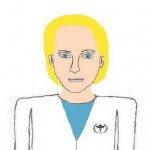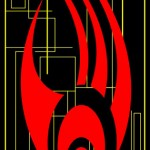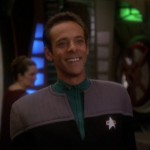Continuing my series of postings regarding the similarities amongst the various science fiction franchises, we move on to mysteries of the universe. Not the usual philosophical questions about the meaning of life, but more concrete mysteries. Among such mysteries are long-dead civilizations that existed as far back as before our race was born and before our sun was “burning hot in space.” And why most of the alien races are humanoids of the two-armed, two-legged variety. Various science fiction franchises have given their own “in-universe” explanations for that phenomenon and created a universe shrouded in mysteries left behind by alien races that predate humanity.
The original Star Trek series introduced “Hodgkin’s Law of Parallel Planet Development.” Simply put, planets with similar environments and similar populations result in largely similar biological developments. Planets with environmental conditions similar to Earth evolve roughly similar plant and animal species. And of course, the sentient species native to those planets are largely human in outward appearance. Of course, back in the 1960’s, Star Trek was a very low-budget series where even the Klingons looked closely human (with an in-universe explanation not provided until 2005 during the franchise’s fifth televised series).
Further examination of the various planets in the Star Trek universe indicates that the civilizations there are very similar historically and sociologically. The most extreme examples appear on planets Omega IV, 892-IV and Miri’s world, (See Memory Alpha’s page on Hodgkin’s Law for further information) with additional examples including Beta III, Eminiar VII, Ekos, Sigma Iotia III, and Gamma Trianguli VI. Perhaps, the actions of an ancient race of humanoids can explain this phenomenon. Seeing that the rest of the Milky Way galaxy was devoid of other sentient life, these humanoids seeded the oceans of thousands of worlds with genetic building blocks more than 3 billion years ago. The ancient interstellar empire led by Sargon 500 thousand years may also have seeded the worlds that race colonized, which may have included Vulcan. Perhaps that would explain the ancient Vulcan-Romulan schism.
Much in the Star Trek universe is still left to the imagination. The universe of the Stargate franchise does offer a more concrete explanation for various alien races having human-like appearances. And that explanation is that they are all ancient offshoots of the human race. Furthermore, the human race is learned in “Stargate: Atlantis” not to have actually originated on Earth or even in this galaxy. Just as indicated in the Star Trek: The Next Generation episode “The Chase”, the first species of humans seeded a countless number of worlds in many different galaxies. Yet by some unexplained fluke, the humans of the Milky Way originate solely on Earth. Still, humans reside on a countless number of planets in the Milky Way courtesy of the Goa’uld. This warlike race of sentient parasites that took humanoid host bodies (similar to the parasites of the TNG episode “Conspiracy”) had taken humans from Earth millennia ago, all the while masquerading as gods in ancient mythology, to serve as slaves and as host bodies. The enslaved humans mined a fictional mineral critical in maintaining the interstellar stargate system. When a planet’s supplies of that mineral ran out, the Goa’uld left the human inhabitants to fend for themselves. That practice has resulted in a number of different worlds whose civilizations closely resemble various ancient Earth civilizations—i.e. Greek, Roman, Egyptian, Chinese, Nordic, Aztec—with little or no change over the centuries. On the other extreme, the Tollan civilization never experienced the Dark Ages, and thus are between five hundred and a thousand years more technologically advanced than its Earth cousins.
The “Babylon 5” universe, on the other hand, never provided any specific “in-universe” explanations how most of the alien races are mostly human appearance. A few of the alien species have anatomical quirks here and there, and a few who don’t breathe oxygen that are more than an afterthought during the course of the series. Most of the alien races prominently featured on-screen share various cultural universals with a few mysterious occurrences such as every sentient race having its own version of Swedish meatballs.
B5 did feature a number of alien races that predated all the humanoid civilizations and were almost godlike in terms of how they manipulated the “younger races”. The enigmatic Vorlon ambassador Kosh usually traveled in an environmental suit while in the presence of others, later revealing that he would otherwise be recognized by everyone. When a situation arose where he had to shed that protective suit, representatives from various alien races saw him as a mythic figure in their religions. Furthermore, a number of humanoid races saw the Shadows and their servant races as demonic beings similar to zombies and vampires, agents of chaos, or lords of darkness. Both of these alien civilizations that predated humanity and its peers by millions of years have had significant roles in the development of the relatively newer civilizations. The Vorlons served as lords of order, and the Minbari became their prospective heirs. The Shadows believed that strength came from conflict and a belief in survival of the fittest. The Dilgar and the Lumati have rigidly followed this philosophy while humans, Centauri, and Narns followed the philosophies of both the Shadows and Vorlons.
And that’s the long and short of various mysteries of the universe featured in three different sci-fi franchises. As Samuel Clemens put it in “Time’s Arrow”, mankind has only existed a “microscopic fraction” of Earth’s lifetime. We haven’t entirely counted out the existence of extraterrestrial life nor has the notion of alien civilizations millions of years older than humanity. It’s an interesting source of speculation even as research is ongoing regarding the “God particle”.







Recent Comments